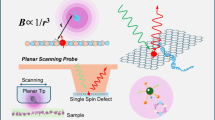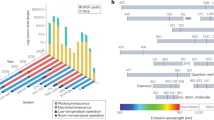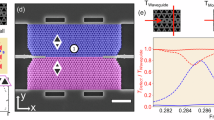Abstract
Zero-dimensional quantum dots (QDs), which have inherent quantum confinement effects and sharp discrete energy levels, are regarded as essential building blocks for quantum information devices. Current manufacturing strategies often exhibit limited adaptability in terms of compositional design or interface engineering. Here we propose a van der Waals (vdW) epitaxial strategy for growing intrinsic QDs by modulating the interfacial couplings between vdW surfaces and QDs. Versatile III–V (MX, M = Ga, In; X = As, Sb) and IV–VI (SnTe) QDs were fabricated without considering the lattice mismatch constraints, leading to QDs with more intrinsic features. We further demonstrated that the as-grown InSb QDs/MoS2 showed a broadened photoresponse in the near-infrared region due to the efficient charge-transfer channels at their vdW interfaces. This work reports a synthetic route to the all-in-solid epitaxy of QDs, which may expand the optoelectronic applications of QDs beyond those that are conventionally grown.

This is a preview of subscription content, access via your institution
Access options
Subscribe to this journal
Receive 12 digital issues and online access to articles
118,99 € per year
only 9,92 € per issue
Buy this article
- Purchase on SpringerLink
- Instant access to full article PDF
Prices may be subject to local taxes which are calculated during checkout





Similar content being viewed by others
Data availability
All of the source data supporting the findings of this study are available in the main text, Extended Data and Supplementary Information.
References
Hong, H. et al. Giant enhancement of optical nonlinearity in two-dimensional materials by multiphoton-excitation resonance energy transfer from quantum dots. Nat. Photon. 15, 510–515 (2021).
Wang, Y. et al. Near resonant and nonresonant third-order optical nonlinearities of colloidal InP/ZnS quantum dots. Appl. Phys. Lett. 102, 021917 (2013).
Chen, S. et al. Electrically pumped continuous-wave III–V quantum dot lasers on silicon. Nat. Photon. 10, 307–311 (2016).
Park, Y.-S. et al. Colloidal quantum dot lasers. Nat. Rev. Mater. 6, 382–401 (2021).
Whitworth, G., Dalmases, M., Taghipour, N. & Konstantatos, G. Solution-processed PbS quantum dot infrared laser with room-temperature tunable emission in the optical telecommunications window. Nat. Photon. 15, 738–742 (2021).
Keuleyan, S., Lhuillier, E., Brajuskovic, V. & Guyot-Sionnest, P. Mid-infrared HgTe colloidal quantum dot photodetectors. Nat. Photon. 5, 489–493 (2011).
Konstantatos, G. et al. Ultrasensitive solution-cast quantum dot photodetectors. Nature 442, 180–183 (2006).
García de Arquer, F. P., Armin, A., Meredith, P. & Sargent, E. H. Solution-processed semiconductors for next-generation photodetectors. Nat. Rev. Mater. 2, 1–17 (2017).
Lu, C.-Y. & Pan, J.-W. Quantum-dot single-photon sources for the quantum internet. Nat. Nanotech. 16, 1294–1296 (2021).
Kandel, Y. P. et al. Adiabatic quantum state transfer in a semiconductor quantum-dot spin chain. Nat. Commun. 12, 2156 (2021).
Kagan, C. R., Lifshitz, E., Sargent, E. H. & Talapin, D. V. Building devices from colloidal quantum dots. Science 353, aac5523 (2016).
Liu, M. et al. Colloidal quantum dot electronics. Nat. Electron. 4, 548–558 (2021).
Liu, S. et al. Efficiently passivated PbSe quantum dot solids for infrared photovoltaics. ACS Nano 15, 3376–3386 (2021).
Böhm, M. L. et al. Lead telluride quantum dot solar cells displaying external quantum efficiencies exceeding 120%. Nano Lett. 15, 7987–7993 (2015).
Won, Y.-H. et al. Highly efficient and stable InP/ZnSe/ZnS quantum dot light-emitting diodes. Nature 575, 634–638 (2019).
Lim, J., Park, Y.-S. & Klimov, V. I. Optical gain in colloidal quantum dots achieved with direct-current electrical pumping. Nat. Mater. 17, 42–49 (2018).
Livache, C. et al. A colloidal quantum dot infrared photodetector and its use for intraband detection. Nat. Commun. 10, 2125 (2019).
Chen, B. et al. Low dark current high gain InAs quantum dot avalanche photodiodes monolithically grown on Si. ACS Photon. 7, 528–533 (2020).
Liu, H. et al. Long-wavelength InAs/GaAs quantum-dot laser diode monolithically grown on Ge substrate. Nat. Photon. 5, 416–419 (2011).
Huang, J. et al. Defect characterization of InAs/InGaAs quantum dot p-i-n photodetector grown on GaAs-on-V-grooved-Si substrate. ACS Photon. 6, 1100–1105 (2019).
Holewa, P. et al. Thermal stability of emission from single InGaAs/GaAs quantum dots at the telecom O-band. Sci. Rep. 10, 21816 (2020).
Prieto, J., Armelles, G., Groenen, J. & Carles, R. Size and strain effects in the E1-like optical transitions of InAs/InP self-assembled quantum dot structures. Appl. Phys. Lett. 74, 99–101 (1999).
Guanjie, Z. et al. Raman scattering of InAs quantum dots with different deposition thicknesses. J. Semicond. 27, 1012–1015 (2006).
Dong, J., Zhang, L., Dai, X. & Ding, F. The epitaxy of 2D materials growth. Nat. Commun. 11, 5862 (2020).
Zhang, L., Dong, J. & Ding, F. Strategies, status, and challenges in wafer scale single crystalline two-dimensional materials synthesis. Chem. Rev. 121, 6321–6372 (2021).
Liu, C., Wang, L., Qi, J. & Liu, K. Designed growth of large‐size 2D single crystals. Adv. Mater. 32, 2000046 (2020).
Chang, W.-H. et al. Efficient single-photon sources based on low-density quantum dots in photonic-crystal nanocavities. Phys. Rev. Lett. 96, 117401 (2006).
Yuan, Z. et al. Electrically driven single-photon source. Science 295, 102–105 (2002).
Uppu, R. et al. On-chip deterministic operation of quantum dots in dual-mode waveguides for a plug-and-play single-photon source. Nat. Commun. 11, 3782 (2020).
Ibanez, J. et al. Strain relaxation in stacked InAs/GaAs quantum dots studied by Raman scattering. Appl. Phys. Lett. 83, 3069–3071 (2003).
Künzel, H. & Ploog, K. The effect of As2 and As4 molecular beam species on photoluminescence of molecular beam epitaxially grown GaAs. Appl. Phys. Lett. 37, 416–418 (1980).
Ma, H. et al. Enhanced hot carrier up‐conversion in graphene by quantum dot coating. Adv. Opt. Mater. 10, 2101563 (2022).
Hu, C. et al. Synergistic effect of hybrid PbS quantum dots/2D‐WSe2 toward high performance and broadband phototransistors. Adv. Funct. Mater. 27, 1603605 (2017).
Konstantatos, G. et al. Hybrid graphene–quantum dot phototransistors with ultrahigh gain. Nat. Nanotech. 7, 363–368 (2012).
Kresse, G. & Furthmüller, J. Efficiency of ab-initio total energy calculations for metals and semiconductors using a plane-wave basis set. Comput. Mater. Sci. 6, 15–50 (1996).
Kresse, G. & Furthmüller, J. Efficient iterative schemes for ab initio total-energy calculations using a plane-wave basis set. Phys. Rev. B 54, 11169 (1996).
Perdew, J. P., Burke, K. & Ernzerhof, M. Generalized gradient approximation made simple. Phys. Rev. Lett. 77, 3865 (1996).
Henkelman, G., Uberuaga, B. P. & Jónsson, H. A climbing image nudged elastic band method for finding saddle points and minimum energy paths. J. Chem. Phys. 113, 9901–9904 (2000).
Sheppard, D., Terrell, R. & Henkelman, G. Optimization methods for finding minimum energy paths. J. Chem. Phys. 128, 134106 (2008).
Acknowledgements
This work was financially supported by the National Natural Science Foundation of China (grant numbers 62222408 (to S.Z.), 62125404 (to Z.W.), 12274404 (to S.Z.), 62375256 (to J.Y.), 52322205 (to C.L.), 52250398 (to C.L.) and 12274456 (to C.L.)), in part by the Youth Innovation Promotion Association of the Chinese Academy of Sciences (grant number 2022112 (to S.Z.)), the Beijing Natural Science Foundation (grant number Z220005 (to Z.W.)), the National Key Research and Development Program of China (grant numbers 2020YFB1506400 (to Z.W.) and 2022YFA1405600 (to C.L.)), the Strategic Priority Research Program of Chinese Academy of Sciences (grant number XDB43000000 (to Z.W.) and XDB0460000 (to H.-X.D.)), and the CAS Project for Young Scientists in Basic Research (grant number YSBR-026 (to Z.W.)).
Author information
Authors and Affiliations
Contributions
S.Z., Z.W., F.L. and C.L. supervised the project. K.X., L.L. and Z.Z. conducted the sample growth and characterizations. K.X. and Z.Z. wrote the article. C.Z. performed the theoretical calculations. J.Y., H.-X.D., J.Z., J.L. and K.L. revised the manuscript. All the authors discussed the results and commented on the manuscript.
Corresponding authors
Ethics declarations
Competing interests
The authors declare no competing interests.
Peer review
Peer review information
Nature Synthesis thanks Chen Shang and the other, anonymous, reviewer(s) for their contribution to the peer review of this work. Primary Handling Editor: Alexandra Groves, in collaboration with the Nature Synthesis team.
Additional information
Publisher’s note Springer Nature remains neutral with regard to jurisdictional claims in published maps and institutional affiliations.
Extended data
Extended Data Fig. 1 Schematics of QDs grown by vdW epitaxy and coherent epitaxy.
a, The non-layered stable phase tends to reduce the surface energy, hence forming QDs with large aspect ratios on vdW substrates. b, Typical coherent epitaxy commonly requires a wetting layer to accumulate stress followed by strain release to form QDs.
Extended Data Fig. 2 InAs QDs grown on wafer-scale FL mica with highly uniform distribution of size and density.
a, Photograph of a 2-inch FL mica on which InAs QDs were grown. b, AFM images of InAs QDs grown on the 2-inch FL mica wafer at nine positions denoted by the red dots. The insets show the magnified views of InAs QDs at the centre square with 200 nm sides of each position (80 μm×80 μm).
Extended Data Fig. 3 Regulation of the QD size and density by substrate temperature and growth time.
a-f, InAs QDs grown on FL mica at 200 °C, 220 °C, 250 °C, 280 °C, 310 °C, and 340 °C for 1 min, leading to densities of 1.6×1011 cm−2, 2.5×1010 cm−2, 1.0×109 cm−2, 2.4×108 cm−2, 4.0×107 cm−2, and 2.5×107 cm−2, respectively. g-i, InAs QDs grown on FL mica at 280 °C for 30 s, 3 min, and 5 min, leading to average sizes of 10 nm, 20 nm, and 50 nm, respectively.
Extended Data Fig. 4 Epitaxial relationship between InAs QDs and FL mica.
a, Cross-sectional high-resolution transmission electron microscopy (HRTEM) image of a series of InAs QDs on FL mica. b-d, Three magnified views of InAs QDs with lattice configuration of InAs-(111) contacting the vdW surface of FL mica.
Supplementary information
Supplementary Information
Supplementary Figs. 1–9 and Note 1.
Supplementary Data 1
Source data for Supplementary Fig. 1.
Supplementary Data 2
Source data for Supplementary Fig. 5.
Supplementary Data 3
Numerical experimental data for Supplementary Fig. 6.
Supplementary Data 4
Source data for Supplementary Fig. 8.
Source data
Source Data Fig. 1
Statistical source data.
Source Data Fig. 2
Statistical source data.
Source Data Fig. 3
Statistical source data.
Source Data Fig. 5
Statistical source data.
Rights and permissions
Springer Nature or its licensor (e.g. a society or other partner) holds exclusive rights to this article under a publishing agreement with the author(s) or other rightsholder(s); author self-archiving of the accepted manuscript version of this article is solely governed by the terms of such publishing agreement and applicable law.
About this article
Cite this article
Xin, K., Li, L., Zhou, Z. et al. Epitaxial growth of quantum dots on van der Waals surfaces. Nat. Synth 3, 1176–1183 (2024). https://doi.org/10.1038/s44160-024-00562-0
Received:
Accepted:
Published:
Issue Date:
DOI: https://doi.org/10.1038/s44160-024-00562-0



